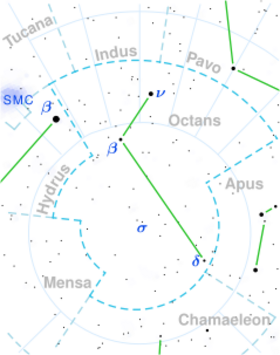Astronomy:Gamma1 Octantis
| Observation data Equinox J2000.0]] (ICRS) | |
|---|---|
| Constellation | Octans |
| Right ascension | 23h 52m 06.48895s[1] |
| Declination | −82° 01′ 07.7489″[1] |
| Apparent magnitude (V) | 5.10[2] |
| Characteristics | |
| Spectral type | G7III[3] |
| U−B color index | +0.60[4] |
| B−V color index | +0.92[4] |
| Astrometry | |
| Radial velocity (Rv) | +15.4±0.1[5] km/s |
| Proper motion (μ) | RA: −48.74[1] mas/yr Dec.: −21.16[1] mas/yr |
| Parallax (π) | 12.30 ± 0.17[1] mas |
| Distance | 265 ± 4 ly (81 ± 1 pc) |
| Absolute magnitude (MV) | 0.55[2] |
| Details | |
| Mass | 1.81[6] M☉ |
| Radius | 11[6] R☉ |
| Luminosity | 68.74[2] L☉ |
| Surface gravity (log g) | 2.64[6] cgs |
| Temperature | 5,150[7] K |
| Metallicity [Fe/H] | −0.34[8] dex |
| Rotational velocity (v sin i) | 1.8[9] km/s |
| Other designations | |
| Database references | |
| SIMBAD | data |
Gamma1 Octantis, Latinized from γ1 Octantis, is a single,[10] yellow-hued star in the constellation which includes the southern celestial pole, Octans. Its apparent visual magnitude is 5.10,[2] meaning that in good conditions it is bright enough to be faintly visible to the naked eye.
Distance and proper motion
Based upon an annual parallax shift of 12.30 mas which is taken during opposing points of the Earth's orbit of the sun (with compensation for its eccentricity),[1] the star is about 265 light years away. Its (proper) motion has a net vector at present of receding from the Sun, at +15.4 km/s.[5]
Characteristics
This is an evolved G-type giant star with a stellar classification of G7 III.[3] It is a red clump star,[7] which means it is generating energy through helium fusion at its core. The star has an estimated 1.81[6] times the mass of the Sun and it has expanded to 11[6] times the Sun's radius. It is radiating 69[2] times the Sun's luminosity from its enlarged photosphere at an effective temperature of 5,150 K.[7]
Gap between stars sharing Gamma designation
The very similar brightness and potentially close stars of Gamma2, 3 have been examined by the Gaia space telescope/observatory. Gamma2 is much more distant than the other two whose margins of error overlap when parallaxes are considered — they may thus be close enough to be in loose mutual orbital. These distances from our star system per Gaia's second Data Release (DR2) are, respectively, around 319 ± 5 ly and 259 ± 3 ly. The observation refines Gamma1 as being 262 ± 4 ly away.
References
- ↑ 1.0 1.1 1.2 1.3 1.4 1.5 Van Leeuwen, F. (2007). "Validation of the new Hipparcos reduction". Astronomy and Astrophysics 474 (2): 653–664. doi:10.1051/0004-6361:20078357. Bibcode: 2007A&A...474..653V. Vizier catalog entry
- ↑ 2.0 2.1 2.2 2.3 2.4 Anderson, E.; Francis, Ch. (2012). "XHIP: An extended hipparcos compilation". Astronomy Letters 38 (5): 331. doi:10.1134/S1063773712050015. Bibcode: 2012AstL...38..331A. Vizier catalog entry
- ↑ 3.0 3.1 Hoffleit, D.; Warren, W. H. (1995). "VizieR Online Data Catalog: Bright Star Catalogue, 5th Revised Ed. (Hoffleit+, 1991)". VizieR On-line Data Catalog: V/50. Originally Published in: 1964BS....C......0H 5050. Bibcode: 1995yCat.5050....0H.
- ↑ 4.0 4.1 Mallama, A. (2014). "Sloan Magnitudes for the Brightest Stars". The Journal of the American Association of Variable Star Observers 42 (2): 443. Bibcode: 2014JAVSO..42..443M.Vizier catalog entry
- ↑ 5.0 5.1 Gontcharov, G. A. (2006). "Pulkovo Compilation of Radial Velocities for 35 495 Hipparcos stars in a common system". Astronomy Letters 32 (11): 759–771. doi:10.1134/S1063773706110065. Bibcode: 2006AstL...32..759G.
- ↑ 6.0 6.1 6.2 6.3 6.4 Allende Prieto, C.; Lambert, D. L. (1999). "Fundamental parameters of nearby stars from the comparison with evolutionary calculations: Masses, radii and effective temperatures". Astronomy and Astrophysics 352: 555–562. Bibcode: 1999A&A...352..555A. Vizier catalog entry
- ↑ 7.0 7.1 7.2 Gontcharov, G. A. (2009). "Red giant clump in the Tycho-2 catalogue". Astronomy Letters 34 (11): 785–796. doi:10.1134/S1063773708110078. Bibcode: 2008AstL...34..785G. Vizier catalog entry
- ↑ Soubiran, Caroline; Le Campion, Jean-François; Brouillet, Nathalie; Chemin, Laurent (2016). "The PASTEL catalogue: 2016 version". Astronomy & Astrophysics 591: A118. doi:10.1051/0004-6361/201628497. Bibcode: 2016A&A...591A.118S.
- ↑ De Medeiros, J. R.; Alves, S.; Udry, S.; Andersen, J.; Nordström, B.; Mayor, M. (2014). "A catalog of rotational and radial velocities for evolved stars". Astronomy & Astrophysics 561: A126. doi:10.1051/0004-6361/201220762. Bibcode: 2014A&A...561A.126D. Vizier catalog entry
- ↑ Eggleton, P. P.; Tokovinin, A. A. (September 2008). "A catalogue of multiplicity among bright stellar systems". Monthly Notices of the Royal Astronomical Society 389 (2): 869–879. doi:10.1111/j.1365-2966.2008.13596.x. Bibcode: 2008MNRAS.389..869E.
 |


